Alstroemeria
Alstroemeria is named after the Swedish botanist Baron Klas von Alstroemer. This South American flower's seeds were among many collected by von Alstroemer on a trip to Spain in 1753.
Aster
There are over 600 species of aster, the most popular being the Monte Casino. Ancient people believed that the odor of its leaves, when burnt, drove away serpents. The English gave this flower two names, asters and starworts. Aster is Latin for star, and referred to its star-like shape. Wort meant root, which signified plants with healing properties. And Asters were laid on the graves of French soldiers to symbolize the wish that things had turned out differently.
Calendula
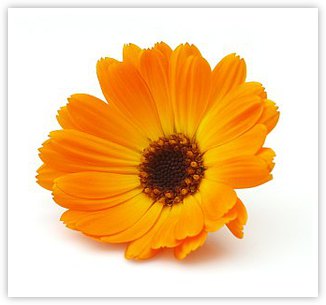
The calendula is a member of the marigold family, and was traditionally valued as an herb, rather than its bright yellow blossoms. The Romans used Calendula mixed with vinegar to season their meat and salad dishes. Calendula blossoms in wine were purported to soothe indigestion, and the petals were used in ointments that cured skin irritations, jaundice, sore eyes, and toothaches.
Very early Christians called this flower Mary's Gold, and placed it by the statues of the Virgin Mary. Again associated with religion and healing, Calendula is the most sacred flower of ancient India… its flower heads were used to make garlands, which adorned holy statues.
The calendula's genus name, wor calendae, means throughout the months. Like sunflowers, Calendula's flower heads follows the sun.
Carnation
Carnations have been cultivated for the last 2,000 years, and they hail from the Near East. It is said that the name, Carnation, comes from Greece… carnis (flesh) refers to the original color of the flower, or perhaps the word incarnacyon (incarnation), which refers to the incarnation of God made flesh.
Another possibility… Carnation could come from "coronation" or "corone" (flower garlands), as it was one of the flowers used in Greek ceremonial crowns. This popular flower was also called dianthus by the Greek botanist Theopharastus.
Chrysanthemum
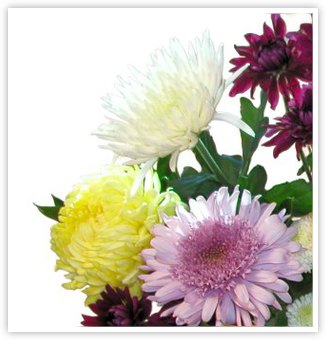
Chrysanthemums had been cultivated in Chinese gardens for more than 2,500 years before they were first exhibited in England in 1795. The ancient Chinese named the Chrysanthemum ("chu hua"), to be their official Flower for October, and also the official badge of the Old Chinese Army. Mums were considered one of the four Chinese noble plants… along with bamboo, the plum, and the orchid, and therefore the lower class Chinese were not permitted to grow them in their gardens.
Visiting Buddhist monks brought the chrysanthemum to Japan in AD 400. Japanese emperors so loved this flower that they sat upon chrysanthemum thrones, and kikus, chrysanthemums in Japanese, were featured on the Imperial Crest of Japan.
Even today, the chrysanthemum is a symbol of the sun, and the orderly unfolding of the mum's petals denotes perfection. One of their traditions is to put a single chrysanthemum petal on bottom of a wine glass to sustain a long and healthy life.
This popular perennial's name is derived from the Greek chrysos (gold) and anthos (flower). In Italy chrysanthemums are associated with death, so don’t give an Italian girl friend a bouquet of chrysanthemums!
Daisy
According to an old Celtic legend, the spirits of children who died in childbirth scattered daisies on the earth to cheer their sorrowing parents.
Beautiful gold hairpins, each ending in a daisy-like ornament were found when the Minoan palace on the Island of Crete was excavated. They are believed to be more than 4000 years old. Egyptian ceramics are also decorated with daisies.
This flower’s English name was day's eye, referring to the way this flower opens and closes with the sun. And primitive medical men drew the obvious conclusion that it was plainly intended to cure eye troubles. Assyrians crushed daisies and mixed them with oil to turn gray hair dark again.
Marguerite, the French word for daisy, is derived from a Greek word meaning "pearl". Francis I called his sister Marguerite of Marguerites and the lady used the daisy as her device, so did Margaret of Anjou the wife of Henry IV and Margaret Beaufort, mother of Henry VII. There is an old English saying that spring has not come until you can set your foot on twelve daises.
King Henry VIII ate dishes of daisies to relieve himself from his stomach-ulcer pain. And a common remedy for insanity was to drink crushed daisies steeped in wine, in small doses for 15 days.
Dahlia
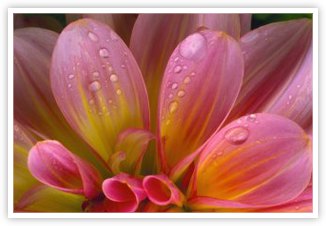
An herbal document written in Latin just sixty years after the coming of Columbus was discovered 1929. It noted that the Aztecs used dahlias as a treatment for epilepsy. The Aztec culture in Mexico was quite advanced but its wealth of written records did not survive the introduction of Christianity. The Aztec Herbal is an astonishing and remarkable resource for botanists and those studying the history of medicine.
Dahlias were late in coming to Europe. European scientific specialists considered the dahlia as a possible source of food since a disease had destroyed the French potato crop in the 1840s. But the beauty of the dahlia far surpassed its taste.
Before insulin was discovered diabetics were often given a diabetic sugar made from dahlia tubers. Chemicals derived from dahlias are used in clinical tests for liver and kidney functions.
Between 1800 and 1805, Lord and Lady Holland lived in France and in Spain where Lady Holland first saw dahlias that had been introduced to Spain about 15 years before. She sent some home to England and it is on the strength of that shipment that she is given credit for the introduction of the dahlia into England.
Delphinium
Delphinium is from the Greek word delphis, meaning dolphin… the flower resembles the bottle-like nose of a dolphin.
Delphiniums were used by West Coast Native Americans to make blue dye, and European settlers made ink from ground delphinium flowers. The most ancient use of Delphinium flowers was a strong external concoction thought to drive away scorpions.
Gladiolus
The Latin word gladius, meaning "sword," and this flower was named for the shape of its leaves. Gladiolus was also called "xiphium," from the Greek word xiphos, also meaning sword. This flower is said to have represented the Roman gladiators.
British Gladiolus used the stem base (corms) as a poultice and for drawing out thorns and splinters. A mixture of powdered corms and goat's milk was a favorite remedy for colic. In the 18th Century, African Gladioli were imported in large quantities to Europe from South Africa.
Holly
Medieval monks called this plant the Holy Tree. They believed Holly would keep evil spirits away, and protect their home from lightening. The early Romans decorated their hallways with garlands made from Holly for their mid-winter feast, Saturnalia.
Later its pointed leaves represented the crown of thorns worn by Jesus, and the red berries his drops of blood. Holly signified eternal life, and also represented the biblical burning bush in the Old Testament, when God appeared before Moses.
Lily
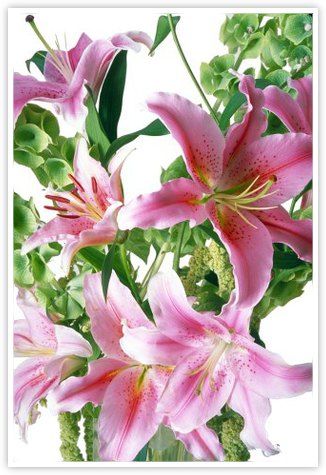
Lilies have been associated with many ancient myths, and pictures of lilies were discovered in a villa in Crete, dating back to the Minoan Period, about 1580 B.C.
Lilies are mentioned in the Old Testament, and in the New Testament, they symbolize chastity and virtue. In both the Christian and pagan traditions, the lily is a fertility symbol. In Greek marriage ceremonies the bride wears a crown of lilies and wheat… purity and abundance. Lilies are also a symbol of death, and at one time lilies were placed on the graves of children.
The lily has no true medicinal value, although In Elizabethan times, lilies were one of the ingredients in medicines to treatment fever, or for cleaning wounds, burns and sores.
Orchid
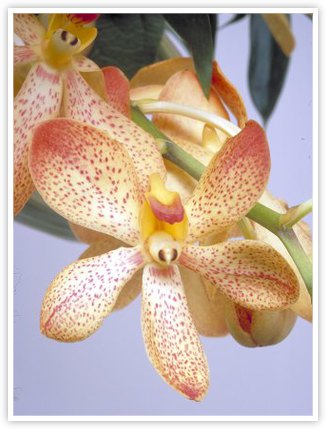
Orchid originates from Greece, where orchis means testicle. Some orchids are called ladies' fingers, ladies' tresses, or long purples. Greek women thought that if the father of their unborn child ate large, new tubers, the baby would be a boy. If the mother ate small tubers, they would give birth to a baby girl.
The most famous orchid, the vanilla orchid, was said to give strength to the Aztecs, who drank vanilla mixed with chocolate.
During the 19th century, Orchids were widely collected. There are nearly 25,000 varieties. Its reproductive behavior has fascinated botanists for years… to germinate, an orchid's seeds need to be penetrated by fungus threads.
Poinsettia
Dr. Joel Roberts-Poinsett, the US Ambassador to Mexico, brought the first poinsettia to the United States in 1928. Poinsettias are known to grow as high as sixteen feet In Mexico. The scarlet color of the original Poinsettias is produced by its bracts… the leaf-like sections that grow before the flower appears.
Because Mexican legends say its bracts resemble the flower of Bethlehem, Poinsettias have the honor of decorating churches at Christmas time. Today, this flower is known worldwide as "the Christmas flower," and you can find shades of cream, pink and scarlet poinsettias adorning homes everywhere.
The Poinsettia is a member of the euphobia, or spurge family. The name originates from the Old French espurg. This plant was used during the Medieval times as a purgative to rid the body of black bile and melancholy.
Queen Anne's Lace
Queen Anne's Lace was named for Queen Anne, wife of King James I of England. The Queen's friends challenged her to create lace as beautiful as the flower.
The root of Queen Anne's Lace, also called "wild carrot," stimulates pigment production in human beings. North African natives chewed it to protect themselves from the sun.
Tiny herb-like flower fossils date back 120 million years!
Rose
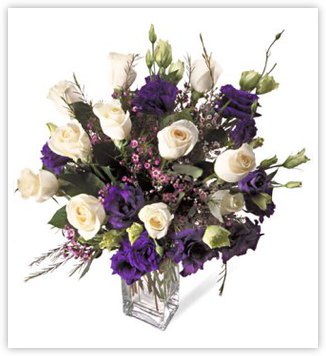
Molecular biologists, who use DNA molecules to estimate age, can trace roses back some 200 million years!
Empress Josephine of France collected 2,562 different roses!
The legends take root….
Cloris, goddess of flowers, crowned the rose as queen of the flowers. Aphrodite presented a rose to her son Eros, god of love. The rose became a symbol of love and desire.
Eros gave the rose to Harpocrates, the god of silence, to induce him not to gossip about his mother's amorous indiscretions. Thus the rose also became the emblem of silence and secrecy. In the middle ages a rose was suspended from the ceiling of a council chamber, pledging all present to secrecy, or sub Rosa, "under the rose".
The first cultivated roses appeared in Asian gardens more than 5,000 years ago. In ancient Mesopotamia, Sargon I, King of the Akkadians (2684-2630 B.C.) brought "vines, figs and rose trees" back from a military expedition beyond the River Tigris
Confucius wrote that during his life (551-479 B.C.), the Emperor of China owned over 600 books about the culture of Roses. The Chinese extracted oil of roses from the plants grown in the Emperor's garden. The oil was only used by nobles and dignitaries of the court. If a commoner were found in possession of even the smallest amount, he was condemned to death!
Roses were introduced to Rome by the Greeks. During feasts young men and women in Athens adorned a crown of roses and danced naked around the temple of Hymen to symbolize the innocence of the Golden Age.
During Roman public games all the streets were strewn with rose petals. Rich Romans provided for the maintenance of huge rose gardens for their gravesites, believing they were pleasing the Spirits of the Dead.
Egyptian wall paintings depicting roses have been found in tombs dating from the fifth century B.C. to Cleopatra’s time. Cleopatra had a passion for everything Roman, and she is said to have scattered rose petals before Mark Anthony's feet. Nero was wild about roses. During lavish Roman dinner parties rose petals rained down from the ceilings of his banquet halls.
Roses were introduced to Europe during the Roman Empire, where they were mainly used for ornamental purposes. Early Christians saw the rose as a symbol of paganism, orgy, and lust. Tertullian wrote an entire volume against the flower and about 202 A.D., and Clement of Alexandra forbade Christians to adorn themselves with roses. Slowly the Church absorbed some aspects of paganism by changing them into Christian. In Catholic litanies, the Virgin Mary is called "Rosa mystica".
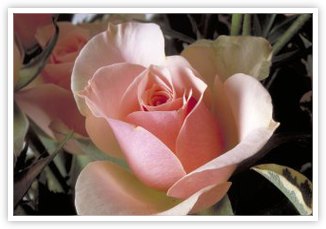
King Childebert I had a rose garden planted for the Queen in Paris. Charlemagne ordered the cultivation of Roses at many. Leo IX, elected Pope in 1084, sent a Golden Rose to favored monarchs… masterpieces created by the goldsmiths.
Returning from the Seventh Crusade, Thibaut IV, Count of Brie and Champagne and King of Navarre (1201-1253) brought back rose bushes from Syria for his wife. Thereafter the French embraced the cultivation of roses, especially the town of Rouen.
The rose became an important heraldic symbol. During the "War of the Roses," the House of York was symbolized by a white rose, the House of Lancaster by a red rose.
Empress Josephine of France started her rose collection at Malmaison in 1804 and within 10 years, she had collected every known species. By 1829 her garden contained 2,562 different roses. Passion for roses spread from France to the British Isles, then throughout Western Europe, and finally to America and Australia.
Rose hips, the fruit produced after the flowering season, were used for the prevention of scurvy, and today we make rose hips teas. Usually we think first of oranges when we need vitamin C… they contain 49 mgs of vitamin C per 100 grams of pulp. On the other hand, Rose hips from the species, Rosa rugosa, contain 2,275 to 6,977 mgs. of vitamin C per 100 grams of pulp!
Snapdragon
We know that Snapdragons were common in the earliest gardens, but their actual origin is not known. Some botanists believe they grew wild in Spain and Italy. In the British countryside, children would gently squeeze the sides of the flower to open and close the "dragon's" mouth.
Sunflower
These flowers always turn towards the sun. They originated in Central and South America, and were grown for their usefulness, not their beauty. In 1532 Francisco Pizarro reported seeing the natives of the Inca Empire in Peru worshipping a giant sunflower. Incan priestesses wore large sunflower disks made of gold on their garments.
Sunflowers represented different meanings in many cultures. In China they symbolized longevity. In the Andes Mountains, golden images of sunflowers were found in temples. And North America Indians in the prairies placed bowls of sunflower seeds on the graves of their dead.
Tulip
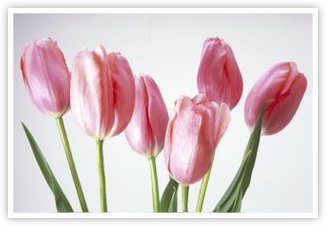
Over a thousand years ago, Tulips grew wild in Persia, and near Kabul the Great Mogul Baber counted thirty-three different species. The word tulip is thought to be a corruption of the Turkish word for turbans. Persian poets sang its praises, and their artists drew and painted it so often, that all of Europe considered the tulip to be the symbol of the Ottoman Empire.
There are people in the world who eat some varieties tulip bulbs, and Japan makes a flour from them. The Dutch have eaten tulip bulbs when no other food was available.
Wealthy people began to purchase tulip bulbs that were brought back from Turkey by Venetian merchants. In 1610, fashionable French ladies wore corsages of tulips, and many fabrics were decorated with tulip designs. In the seventeenth century, a small bed of tulips was valued at 15,000-20,000 francs. The bulbs became a currency, and their value was quoted like stocks and shares.
Tulipmania flourished between 1634-1637… just like the California Gold Rush, people abandoned jobs, businesses, wives, homes and lovers to become tulip growers. The frenzy spread from France, through Europe to the Low Countries.
It is recorded that a Dutchman paid thirty-six bushels of wheat, seventy-two of rice, four oxen, twelve sheep, eight pigs, two barrels of wine and four of beer, two tons of butter, a thousands pounds of cheese, a bed, clothes, and a silver cup… for one Vice-Roi bulb! Hopefully he didn’t eat it.
The crazed population was obsessed beyond reason. Records show one buyer paying twelve acres of land, another buyer paying with his new carriage and twelve horses. The best story… after paying for a bulb with its weight in gold, the new owner heard that a cobbler possessed the same variety. He bought the cobbler’s bulb and crushed it, to increase the value of his first bulb.
The Dutch shipped hundreds of thousands of tulip bulbs to Ottawa, Canada, after World War II to show their gratitude to Canadian soldiers for freeing Holland from the German occupation, and for welcoming Queen Maria to reside in Ottawa while the war raged on.
The wealthy speculated on tulip shares. [The word bourse is derived from the mania… speculators held their meetings at the house of the noble family, Van Bourse.] Most of the bulbs were grown in Flanders by monks. Bulbs were traded like stock using paper representation of ownership. About ten million bulbs were represented in the market. In 1637 speculation became illegal, and many people, especially in Holland, were ruined as prices fell.
An eighteenth century manuscript notes that the Sheik Mohammed Lalizare, official tulip grower of Ahmed (1703-1730) counted 1,323 varieties. Tulips are still popular and there are many exotic varieties that we enjoy in our gardens.
Violet
When Napoleon married Josephine she wore violets, and on each anniversary Josephine received a bouquet of violets. Following Napoleon’s lead, the French Bonapartists chose the violet as their emblem, and nicknamed Napoleon "Corporal Violet". In 1814, Napoleon asked to visit Josephine's tomb before being exiled to the Island of St. Helena. When he died, he wore a locket around his neck that contained violets he had picked from Josephine’s gravesite.
Common sayings include: Dream of violets and advance in life. Wear a garland of violets to prevent dizziness. Violets are considered a good luck gift, but when violets bloom in autumn, epidemics will follow within the year.
Learn more about the history of mail-order clubs and the origins of the other subscription boxes we offer:
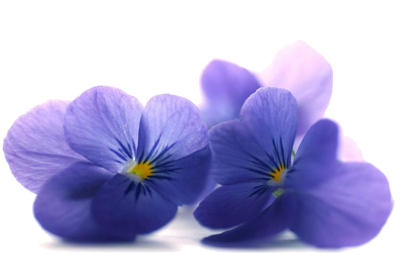
Over 25 Years Experience Shipping Flowers
We’ve shipped hundreds of thousands of bouquets over the years. Our designers
know which blooms ship best, how to pack them, and buy only top-rated blooms.

 Rated Customer Service
Rated Customer Service
Assuring satisfaction to over 2,000,000 CUSTOMERS since 1994 has earned us a Better Business Bureau
rating. A BBB business since 10/05/2005.
100% Satisfaction Guarantee
Our 100% Satisfaction Guarantee ensures that every product you purchase from any of our clubs meets your high standards, contact us within 30 days and we will do our best to make it right or you may cancel your membership at anytime and receive a full refund for any unshipped product.

